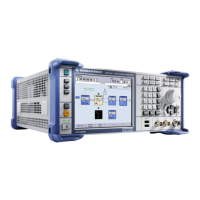Instrument Function
R&S
®
SMBV100A
334Operating Manual 1176.8016.02 ─ 17
Possible applications
●
Use the "Level Attenuation" function to simulate radio stations located at various
distances.
●
Use the "Power Ramp" function if it is necessary to control the RF output signal
envelope synchronously, e.g. by the generation of TDMA signals.
Both the GSM/EDGE and the TD-SCDMA firmware options are equipped with embed-
ded power ramping function. In the GSM/EDGE standard for example, a maximum of 7
different level attenuation values can be defined and allocated separately to the 8 slots
independently of one another.
Impact of the Power Ramping Settings on the Generated Signal
The Figure 5-22 explains the power ramping function in principle. The "Burst Gate" sig-
nal defines the start of the rising and falling edges of the envelope of the output signal,
and the "Lev Att" signal defines the start and end of level attenuation. The signal level
during the attenuation period is a configurable value.
Figure 5-22: Signal behavior when power ramping and level attenuation are enabled
Several parameters are provided for precise definition of the form and the steepness of
ramp. The Figure 5-23 depicts the impact of the provided settings.
●
Ramp function: defines the shape of the rising and falling edges
●
Ramp time: defines the duration of the rising and the falling ramp
●
Rise/fall delay: offsets the falling edge of the envelope at the beginning/end of a
burst
Baseband Signal - Baseband Block

